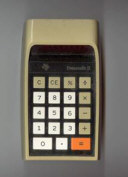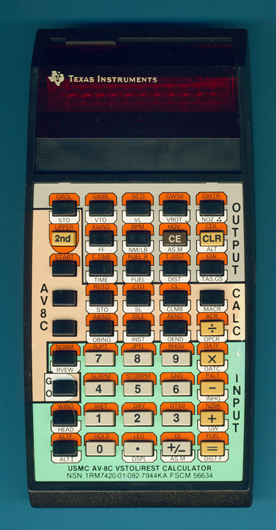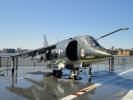
DATAMATH CALCULATOR MUSEUM
 |
DATAMATH CALCULATOR MUSEUM |
USMC AV-8C calculator by Texas Instruments
| Date of introduction: | 1980 | Display technology: | LED-stick |
| New price: | Display size: | 10 (8 + 2) | |
| Size: | 6.4" x 3.2" x
1.5" 162 x 81 x 37 mm3 |
||
| Weight: | 8.5 ounces, 240 grams | Serial No: | 8209115 |
| Batteries: | BP1A | Date of manufacture: | wk 46 year 1981 |
| AC-Adapter: | AC9131 | Origin of manufacture: | USA (ATA) |
| Precision: | 13 | Integrated circuits: | TMC0501E,
TMC0582, TMC0583,
TMC0571, 2*TMC0598 TMC0540 (CD5661) |
| Logic: | AOS - 8 Pending Operations, 9 () | ||
| Memories: | 0-60 | ||
| Program steps: | 480-0 | Courtesy of: | Joerg Woerner |
| Download manual: | |

![]()
 When McDonnell Douglas Aircraft
modified the original AV-8A design of the Harrier to extend its operational
life, it was renamed to AV-8C.
When McDonnell Douglas Aircraft
modified the original AV-8A design of the Harrier to extend its operational
life, it was renamed to AV-8C.
In the same timeframe Texas Instruments replaced the TI-58
used in the USMC Harrier calculator with the TI-58C
and consequently this USMC AV-8C calculator was introduced.
 The Harrier AV-8C model is a AV-8A model that received some
AV-8B upgrades to lengthen its service life including a more powerful engine,
more sophisticated electronic equipment, and aerodynamic improvements. It did
not receive the larger wing, longer fuselage, raised cockpit or radar nose that
distinguishes the AV-8B Harrier II from the AV-8A.
The Harrier AV-8C model is a AV-8A model that received some
AV-8B upgrades to lengthen its service life including a more powerful engine,
more sophisticated electronic equipment, and aerodynamic improvements. It did
not receive the larger wing, longer fuselage, raised cockpit or radar nose that
distinguishes the AV-8B Harrier II from the AV-8A.
 The
innovative TI-58/TI-58C/TI-59 calculators were the perfect base for a lot of
customized products. This one was used in the Eighties by the USMC
(United States Marine Corps) to calculate Takeoff, Landing and Flight maneuvers.
The idea behind these products
was the novelty of the
Solid State Software Modules™ with up to 5000 program steps. This software was
written by the SW-engineers of the McDonnell Douglas Aircraft
company and programmed into the
modules by Texas Instruments.
The
innovative TI-58/TI-58C/TI-59 calculators were the perfect base for a lot of
customized products. This one was used in the Eighties by the USMC
(United States Marine Corps) to calculate Takeoff, Landing and Flight maneuvers.
The idea behind these products
was the novelty of the
Solid State Software Modules™ with up to 5000 program steps. This software was
written by the SW-engineers of the McDonnell Douglas Aircraft
company and programmed into the
modules by Texas Instruments.
 The
customized keyboard hides most functions available on the standard TI-58C and
allows only access to the basic calculation functions and the programmed
functions of the AV-8C module.
The
customized keyboard hides most functions available on the standard TI-58C and
allows only access to the basic calculation functions and the programmed
functions of the AV-8C module.
| British Aerospace
AV-8C Harrier
Most combat aircraft require long runways or an aircraft carrier's poerful catapults to get airborne. Britidh-designed Harrier "Jump Jet". It uses vectored-thrust technology to take off and land vertically. Smaller jet nozzles on the airframe control the aircraft while hovering. The first Harrier GR Mark 1 flew on December 28, 1967. Commissioned by Britain’s Royal Air Force and Royal Navy, the Harrier has a top speed of 661 mph (1065 kph) and first saw combat during the Falklands War (1982). The U.S. Marine Corps realized the Harrier’s potential and made an initial purchase of 110 AV-8A Harrier I planes from Britain in 1970–71. Later McDonnell Douglas AV-8B Harriers were the first Marine Corps tactical strike aircraft to be utilized during Operation Desert Storm (1991), flying 3,342 sorties in over 4,300 flight hours. The Harrier is on loan from the National Museum of the Marine Corps © Copyright 2011 INTREPID Sea, Air & Space Museum. |
If you have additions to the above article please email: joerg@datamath.org.
© Joerg Woerner, November 10, 2004. No reprints without written permission.